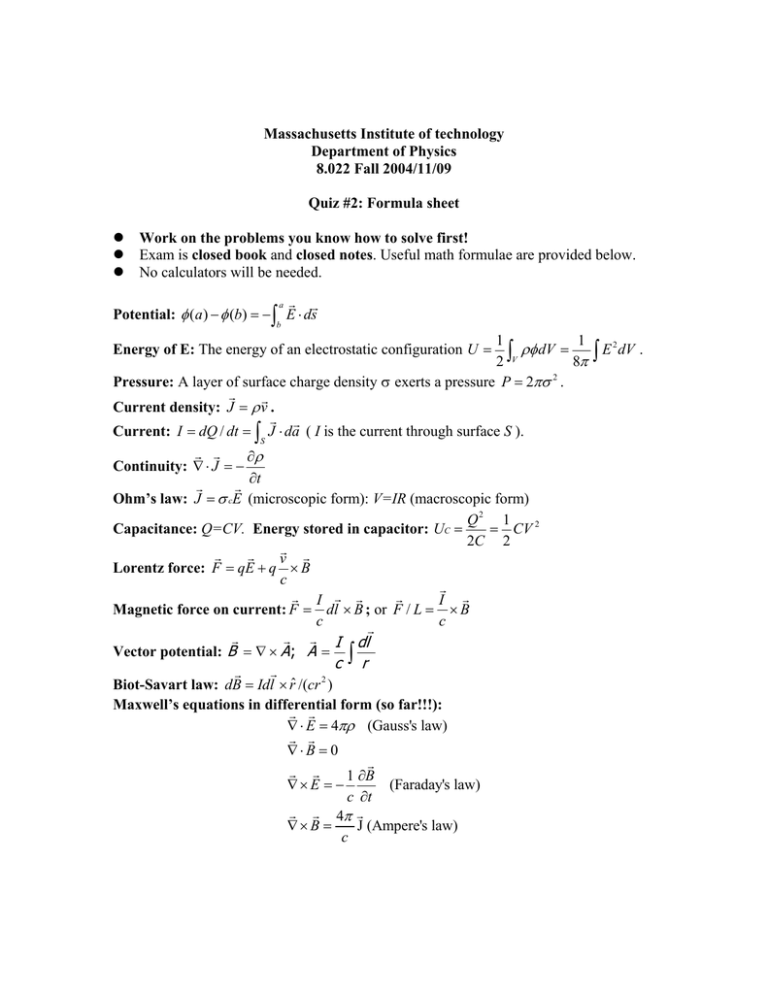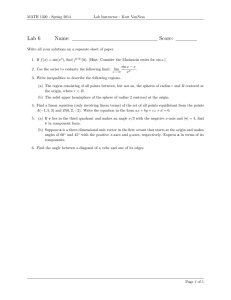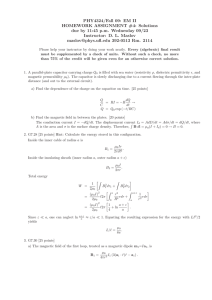Massachusetts Institute of technology Department of Physics 8.022 Fall 2004/11/09
advertisement

Massachusetts Institute of technology Department of Physics 8.022 Fall 2004/11/09 Quiz #2: Formula sheet Work on the problems you know how to solve first! Exam is closed book and closed notes. Useful math formulae are provided below. No calculators will be needed. a Potential: φ (a ) − φ (b) = − ∫ E ⋅ ds b 1 1 ρφ dV = E 2 dV . ∫ 2 V 8π ∫ Pressure: A layer of surface charge density σ exerts a pressure P = 2πσ 2 . Energy of E: The energy of an electrostatic configuration U = Current density: J = ρ v . Current: I = dQ / dt = ∫ J ⋅ da ( I is the current through surface S ). S ∂ρ ∂t Ohm’s law: J = σ cE (microscopic form): V=IR (macroscopic form) Q2 1 Capacitance: Q=CV. Energy stored in capacitor: UC = = CV 2 2C 2 v Lorentz force: F = qE + q × B c I I Magnetic force on current: F = dl × B ; or F / L = × B c c Continuity: ∇ ⋅ J = − Vector potential: B = ∇ × A ; A = I c ∫ dl r Biot-Savart law: dB = Idl × r̂ /(cr 2 ) Maxwell’s equations in differential form (so far!!!): ∇ ⋅ E = 4πρ (Gauss's law) ∇⋅B = 0 ∇× E = − ∇× B = 1 ∂B (Faraday's law) c ∂t 4π J (Ampere's law) c Maxwell’s equations in integral form (so far): ∫ E ⋅ da = 4π Q (Gauss's law. Q is charge enclosed by surface S) S ∫ C E ⋅ ds = − 1 ∂φ B =e.m.f. (Faraday's law. φ B is B flux through surface bounded by C.) c ∂t 4π I (Ampere's law. I is current enclosed by contour C.) C c Self inductance: ε = −LdI / dt Mutual Inductance: ε 1 = −M 12 dI 2 / dt ; ε 2 = −M 21dI 1 / dt ; M 12 = M 21 1 B 2 dV Magnetic energy: U = 8π ∫ 1 Energy stored in an inductor: UL = LI 2 2 ∫ B ⋅ ds = Time dilation: Moving clocks run slow: ∆tstationary = γ∆tmoving Length contraction: Moving rulers are shortened: Lstationary = Lmoving / γ Transformation of fields: denotes parallel to v , ⊥ denotes perpendicular to v v E' = E E⊥' = γ (E⊥ + × B⊥ ) c v B' = B B⊥' = γ (B⊥ − × E⊥ ) c Useful Math Cartesian. ∂t ∂t ∂t x̂ + ŷ + ẑ ∂x ∂y ∂z ∂ v ∂ v y ∂ vz Divergence: ∇ ⋅ v = x + + ∂x ∂y ∂z ∂ v y ∂ vx ∂v ∂v ∂ v ∂ vy ) x̂ + ( x − z ) ŷ + ( − )ẑ Curl: ∇ × v = ( z − ∂y ∂z ∂z ∂x ∂x ∂y Gradient: ∇t = Laplacian: ∇ 2 t = ∂ 2t ∂ 2t ∂ 2 t + + ∂ x2 ∂ y2 ∂ z2 Spherical. ∂t 1 ∂t 1 ∂t r̂ + θ̂ + φ̂ ∂r r ∂θ r sin θ ∂ φ ∂ 1 ∂ 1 1 ∂ vφ ( r 2 v r )+ Divergence: ∇ ⋅ v = 2 (sin θvθ )+ r sin θ ∂ θ r sin θ ∂ φ r ∂r Gradient: ∇t = Curl: ∇×v = ∂ (sin θvφ ) ∂ vθ 1 1 1 ∂ v r ∂ (rvφ ) 1 ∂ (rvθ ) ∂ v r − − − ]θ̂ + [ ]φ̂ [ ]r̂ + [ ∂θ ∂φ ∂r ∂θ r ∂r r sin θ r sin θ ∂ φ ∂t ∂ 2t 1 ∂ 2 ∂t 1 1 ∂ (r )+ (sin θ )+ Laplacian: ∇ t = 2 ∂ r r 2 sin θ ∂θ ∂ θ r 2 sin 2 θ ∂ φ 2 r ∂r 2 Cylindrical. ∂t ∂t 1 ∂t ρ̂ + φ̂ + ẑ ∂ρ ρ ∂φ ∂z 1 ∂ 1 ∂ vφ ∂ v z Divergence: ∇ ⋅ v = ( ρv ρ ) + + ρ ∂ρ ρ ∂φ ∂z ∂v ∂v 1 ∂ vz ∂ vφ 1 ∂ ( ρ vφ ) ∂ vρ Curl: ∇ × v = [ − − ]ρ̂ + [ ρ − z ]φ̂ + [ ]ẑ ρ ∂φ ∂ z ∂z ∂ρ ρ ∂ρ ∂θ ∂t 1 ∂ 2t ∂ 2 t 1 ∂ Laplacian: ∇ 2 t = (ρ )+ 2 + ρ ∂ρ ∂ ρ ρ ∂φ 2 ∂ z 2 Gradient: ∇t = Binomial expansion: (1 ± x )n = 1 ± nx 1! Stokes’ theorem: Gauss’ theorem: + n (n − 1)x 2 2! ± (x 2 < 1);(1 ± x ) −n = 1 ∓ ∫ F ⋅ ds = ∫ curl F ⋅ dA ∫ F ⋅ dA = ∫ div FdV C S S V nx 1! + n (n + 1)x 2 2! ∓ (x 2 < 1) Problem 1 (20 points) Consider the following circuit: S2 S1 R1=R R2=2R S3 + V C R3=3R Initially all switches are open and the capacitor C is discharged. a) At time t=t0, we close S1 and S2 simultaneously. b) At time t=t1 >> t0 we close S3 (with S1 and S2 still closed). c) At time t=t2 >> t1 we open S1 (S2 and S3 still closed). Sketch how the following quantities vary over time: a) VC (potential across capacitor) b) IR2 (current flowing through R2) c) VR3 (potential across R3) NB: please specify asymptotic values and time constants. You do not need to solve differential equations or to write down the explicitly each function. R Problem 2 (30 points) Consider a cylindrical conductor of radius R and infinite length. A current I flows in the conductor. The current density is given by J = Jzˆ = I zˆ πR 2 a) Find the magnetic field everywhere in space. b) Find the vector potential everywhere in space. Assume that A = 0 on the cylinder axis. c) Verify that B = ∇ × A . Hint for part b: remember that ∫ A idl c = ∫ ∇ × A ida = ∫ B ida = Φ S (B ) S A z x y Problem 3 (20 points) A wire bent into a semicircle with a radius r rotates with a constant angular velocity ω. The wire is connected to a resistor R through a conductor of dimensions a and b in the y and x direction respectively to form a closed loop. The loop is placed into a uniform magnetic field B // zˆ (into the page). a) Find the total flux through the loop as function of time. b) Find the e.m.f. created in the loop. Indicate the direction of the current over time. c) While the semicircle rotates, the external magnetic field starts decreasing as B (t ) = B 0e − λt . Find the current I through the resistor as a function of time. Problem 4 (30 points) A flat conducting plate of thickness t has a semicircular structure as depicted in the figure below. Call the inner radius a and the outer radius b. The conductivity of the metal is σ. F E r θ A B C D A potential difference V0 is applied along the semicircular borders: the inner radius BEC is kept at potential V = V0, while the outer radius AFD is kept at potential V = 0. a) Find the potential φ everywhere on the plate, the electric field E , the current density J and the Ohmic resistance of the conductor R. We now change the connections and apply the potential difference along the straight sections: AB is kept at potential V = V0 and CD at V = 0. b) Find the same quantities, i.e. the potential φ, the electric field E , the current density J and the Ohmic resistance of the conductor R.




